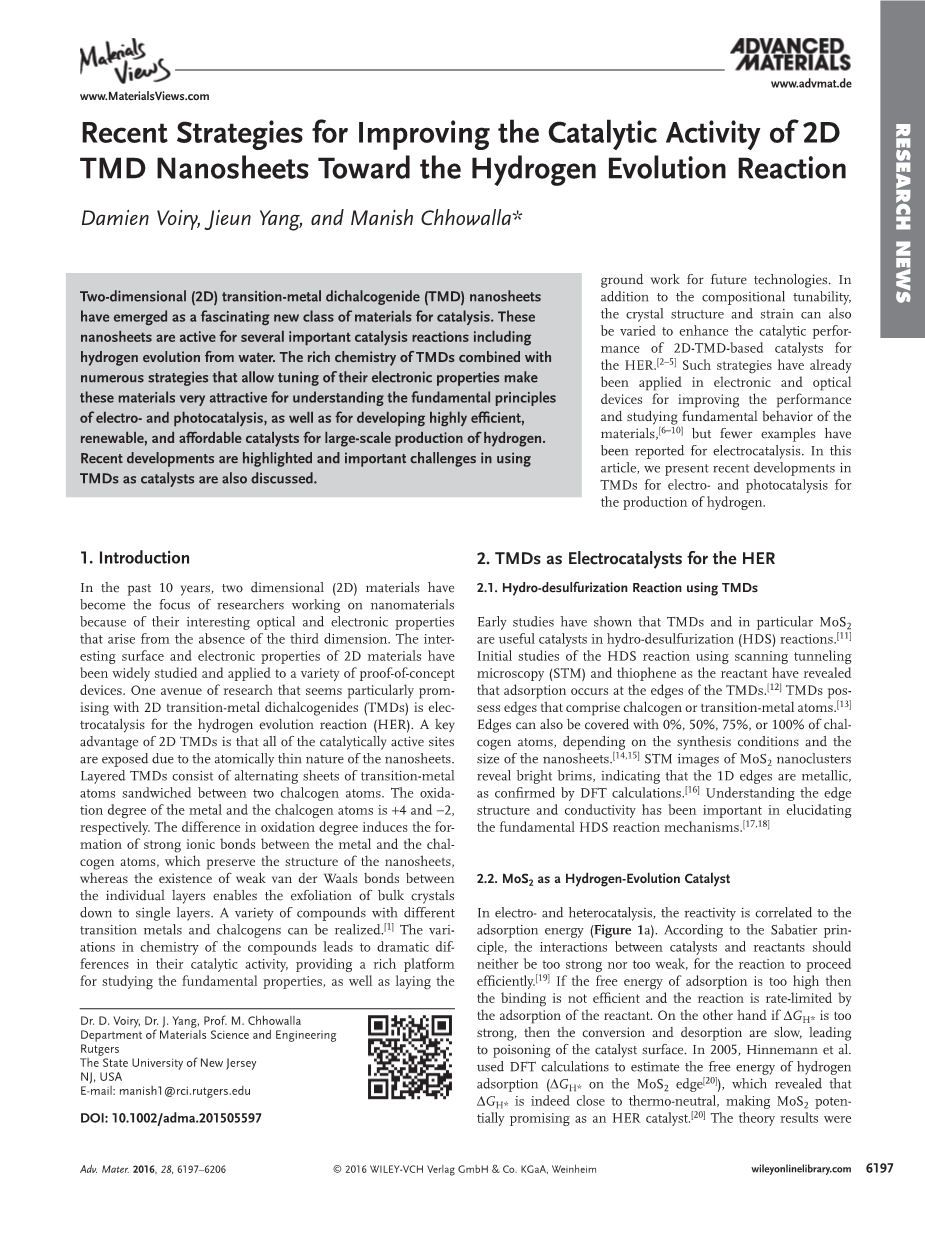
英语原文共 10 页
Two-Dimensional Hybrid Nanosheets of Tungsten Disulfide and Reduced Graphene Oxide as Catalysts for Enhanced Hydrogen Evolution
基于二硫化钨和还原氧化石墨烯的二维复合纳米片的析氢反应催化剂
Two-dimensional (2D) transition-metal dichalcogenide (TMD) nanosheets have emerged as a fascinating new class of materials for catalysis. These nanosheets are active for several important catalysis reactions including hydrogen evolution from water. The rich chemistry of TMDs combined with numerous strategies that allow tuning of their electronic properties make these materials very attractive for understanding the fundamental principles of electro- and photocatalysis, as well as for developing highly efficient, renewable, and affordable catalysts for large-scale production of hydrogen. [1]
二维过渡金属二硫化物(TMD)纳米片成为了一种很具有吸引力的催化剂。这些催化剂对于几个重要的催化反应表现出活性,包括从水中析出氢的反应。TMDs化学组成很丰富,我们可以采用很多种方法来改变这些材料的电性能。这使得这些材料对于我们对电、光催化基本原理的理解,以及开发高效、可再生、价格合理并可大规模制氢的催化剂,非常具有吸引力。[1]
Early studies have shown that TMDs and in particular MoS2 are useful catalysts in hydro-desulfurization (HDS) reactions. Initial studies of the HDS reaction using scanning tunneling microscopy (STM) and thiophene as the reactant have revealed that adsorption occurs at the edges of the TMDs. TMDs possess edges that comprise chalcogen or transition-metal atoms. Edges can also be covered with 0%, 50%, 75%, or 100% of chalcogen atoms, depending on the synthesis conditions and the size of the nanosheets. STM images of MoS2 nanoclusters reveal bright brims, indicating that the 1D edges are metallic, as confirmed by DFT calculations. Understanding the edge structure and conductivity has been important in elucidating the fundamental HDS reaction mechanisms. [1]
早期的研究表明TMDs,特别是MoS2, 是加氢脱硫( HDS )反应中非常有用的催化剂。使用扫描隧道电子显微镜(STM)对噻吩作为反应物的HDS反应的初步研究显示,这种吸附发生在TMD的边缘。TMDs具有由硫属原子或者过渡金属原子构成的边缘。根据合成的条件和纳米片的尺寸,它的边缘可以被硫属原子不同比例覆盖,如0%,50%,75%或者100%。MoS2纳米团簇的扫描电子显微镜显示呈现明亮的边缘,表明一维边是金属性的,这个结论后面也被DFT计算所证实。理解边缘结构和导电性对于阐明加氢脱硫反应机理是很重要的。[1]
In the past 10 years, two dimensional (2D) materials have become the focus of researchers working on nanomaterials because of their interesting optical and electronic properties that arise from the absence of the third dimension. The interesting surface and electronic properties of 2D materials have been widely studied and applied to a variety of proof-of-concept devices. One avenue of research that seems particularly promising with 2D transition-metal dichalcogenides (TMDs) is electrocatalysis for the hydrogen evolution reaction (HER). A key advantage of 2D TMDs is that all of the catalytically active sites are exposed due to the atomically thin nature of the nanosheets.
Layered TMDs consist of alternating sheets of transition-metal atoms sandwiched between two chalcogen atoms. The oxidation degree of the metal and the chalcogen atoms is 4 and minus;2, respectively. The difference in oxidation degree induces the formation of strong ionic bonds between the metal and the chalcogen atoms, which preserve the structure of the nanosheets, whereas the existence of weak van der Waals bonds between the individual layers enables the exfoliation of bulk crystals down to single layers. A variety of compounds with different transition metals and chalcogens can be realized. The variations in chemistry of the compounds leads to dramatic differences in their catalytic activity, providing a rich platform for studying the fundamental properties, as well as laying the ground work for future technologies.In addition to the compositional tunability, the crystal structure and strain can also be varied to enhance the catalytic performance of 2D-TMD-based catalysts for the HER.
Such strategies have already been applied in electronic and optical devices for improving the performance and studying fundamental behavior of the materials, but fewer examples have been reported for electrocatalysis.[1]
在过去的10年中,二维材料已经成为了科学研究者关于纳米材料研究工作的重点,因为他们缺乏三维结构而表现出了有趣的光学和电学性能。二维材料有趣的表面特性和电子特性使得它们被广泛地研究并且应用到很多的概念性器件中。有一个很有前景的二维过渡金属二硫化物研究分支为利用他们的电催化性能进行析氢反应。二维的TMDs的一个主要的优点就是由于纳米片的天生的原子层厚度,所有的催化活性位点都暴露了出来。层状的TMDs由两层硫原子和夹在之间的过渡金属原子交替组成。金属和硫原子的氧化价态分别是 4,-2。氧化程度的差异导致金属和硫属元素原子之间形成强离子键,这保持了纳米片的结构。而单层之间弱范德华键的存在使得块状晶体可剥落至单层。利用不同的过渡金属和硫属元素可以实现合成多种化合物。这些化合物化学性质的不同,使得它们的催化活性具有较大的差异,这为基础性质的研究提供了一个丰富的平台,也为未来的技术发展奠定了基础。为了提高基于二维TMD的催化剂的催化性能,我们除了可以调整组成成分以外,也可以调整晶体结构和形变。这种方法已经一方面应用到电子和光学器件中以改善材料的性能,另一方面应用于材料的基本特性的研究中,但是关于电催化性能的报道比较少。[1]
The need for renewable energy has driven efforts for the development of affordable, earth-abundant catalysts for the production of hydrogen. TMDs have demonstrated promising properties as electro- and photocatalysts for the HER. Metallic TMDs have natural advantages since they can be active from their basal plane with a free energy for hydrogen adsorption that is close to thermo-neutral, and they offer good electrical conductivity. Besides the enhancement of electrocatalytic properties, TMDs also hold promise as photocatalysts. The rich properties of 2D TMDs can be used to harvest sunlight efficiently, separate electron–hole pairs and drive electrons to active sites to facilitate catalytic reactions.It is known that the electronic structure strongly influences the catalytic properties of materials.TMDs offer opportunities for varying and therefore testing different atomic and electronic structures. For example, MoS2or WS2 nanosheets can be prepared with semiconducting trigonal prismatic (2H phase) or metallic octahedral (1T phase) structures by increasing the electron density in the d orbitals of the metal atoms (Figure 3a). Electrochemical stability is a major concern for electro- or photo catalysts. Experimentally, it has been observed that the transition temperature is relatively high compared to the typical temperatures for the HER: 100 °C and 200 °C for 1T-MoS2
您可能感兴趣的文章
- 层沉积催化剂的方法制备催化剂涂层膜与其性能研究外文翻译资料
- 拥有高比功率密度的柔性轻质燃料电池研究外文翻译资料
- 用于超级电容器的纳米结构碳金属氧化物复合电极综述外文翻译资料
- 多功能高温高性能锂硫电池隔膜的设计外文翻译资料
- 通过使用成对溶剂的简单溶胀策略,生成具有原位聚乙 二醇化表面的纳米多孔聚矾外文翻译资料
- 孔径可调的自组装等孔嵌段共聚物膜外文翻译资料
- 实现多晶相分离材料Sn1-xPbxSe的高热电优值外文翻译资料
- 显微结构对TiB2/Al2O3陶瓷动态断裂抗力的影响外文翻译资料
- 受自然界启发设计的高性能的三通道式柔性Li-O2电池外文翻译资料
- Cu纳米粒子高度分散在n掺杂石墨烯上的Li-CO2电池的阴极稳定性鉴定外文翻译资料


